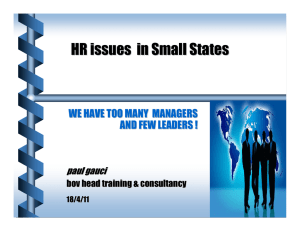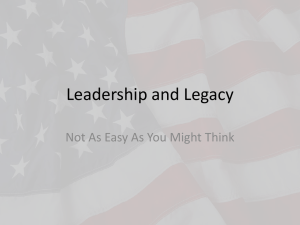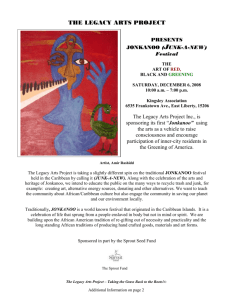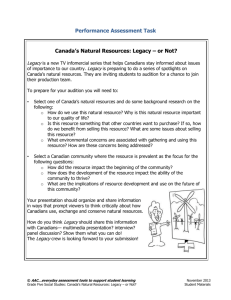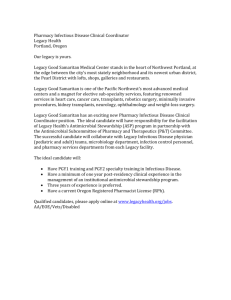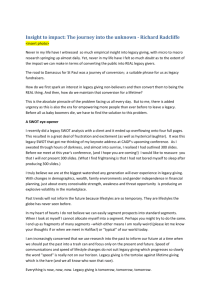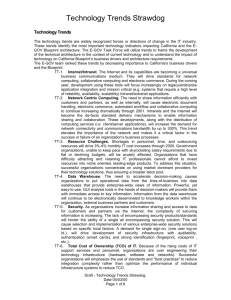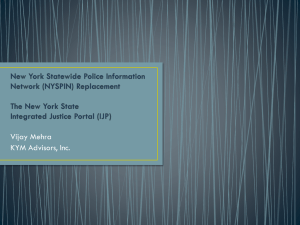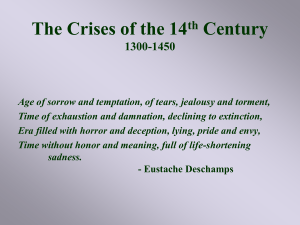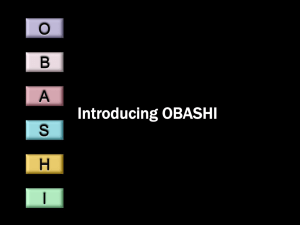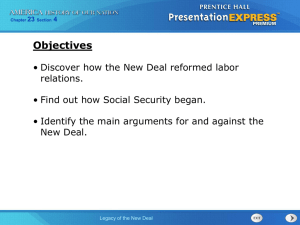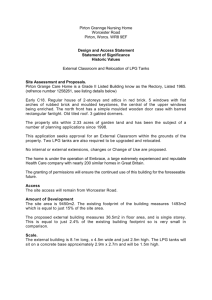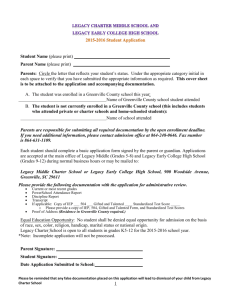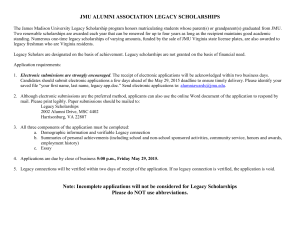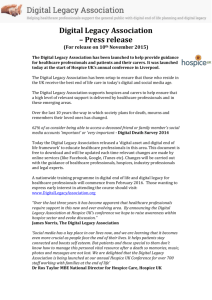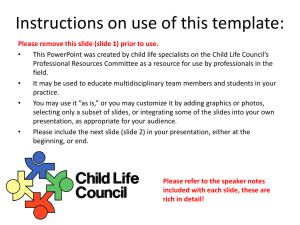NAPD
advertisement
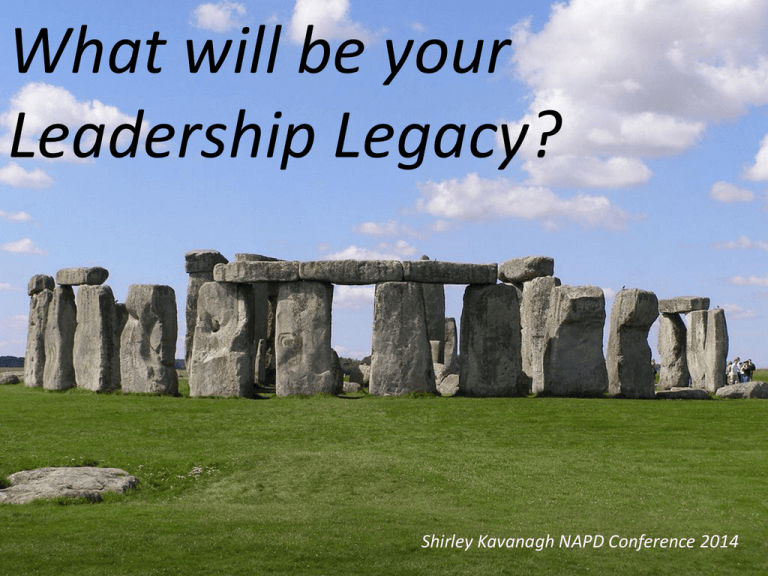
What will be your Leadership Legacy? Shirley Kavanagh NAPD Conference 2014 What is Leadership? "Leadership is one of the most observed and least understood phenomena on earth." Burns 1970. “Leadership is a relationship between those who aspire to lead and those who choose to follow” Jim Kouzes & Barry Posner 1990 “Leadership is the art of getting someone else to do things you want done because they want to do it” Dwight D Eisenhower “Leadership is about influence, nothing more nothing less” John Maxwell “If your actions inspire others to learn more, dream more, do more and become more, you are a leader” John Quincy Adams What you say about Leadership “Leadership is about coping with change” “It’s about being a good listener. You might not like all you hear but your staff somebody who will to listen” “It’s about staying calm. Shut the door and in your office let out that roar!” “Leadership is about having a calmness about you, it reassures others that you are in control” “It’s about being adaptable, about taking charge and about communicating to staff, students and parents” It’s about having an ability to cope with Pressure. Don’t Panic Everyone! Some Assumptions about Leadership • • • • • • • • There is no single, “right” leadership style The ability to lead others is underpinned by a thorough and honest understanding of your own strengths and limitations Leadership is a life-long learning journey – what got you here may not get you to the next step in that journey Leadership requires the mobilisation of creativity and innovation, it does not mean that all new ideas must come from the leader Relationship between those who aspire to lead and those who choose to follow Leadership is grounded on the ability to engage and encourage the hearts of others -- to help them to derive a sense of purpose in and from their work Today relies more upon the ability to connect, than upon the exercise of command and control Leaders must be clear about the imprint they wish to leave on their organisations and then frame their action and behaviours with that legacy in mind And some key assumptions about behaviour Leadership is a fishbowl Performance is contractual -- Effort Is personal Intent is not action Relationships Matter, Sometimes you have to go slow to go fast People have to trust the messenger before they will trust the message Data may guide the head and the hands but stories move the heart Everything’s a theory until you try it 5 The Principals Dilemma - Leadership and Management Management Leadership Coping with complexity Coping with Change Both necessary for success and must be balanced Management Leadership What is a good Leader? Forward Looking Courage Integrity Build Trust Resilient Being able to Inspire Knowing what you don’t know Engage People Some thoughts from Leaders So what can we say now about Leadership Communicate Effectively Authentic Self Aware “Emotionally Intelligent” Resilient Influencing Inspire and Engage People Recognise and develop their people Improve and change things and look for a better way Role model desired behaviours Leave a Footprint Earning the Right to Lead A critical factor impacting peoples’ decision to follow is your authenticity as a leader: • It is the alignment of your actions and objectives with your beliefs and values • It is the ability to be resilient and take the roles very seriously – but not oneself • It is the willingness – as much as the ability- to help others to use their talent and capability to succeed • It is the willingness to lead with and from the heart The Foundations of Authenticity Authentic Leaders • Display a consistency between their words and their deeds – They practice what they preach • Demonstrate coherence in their performance of the different roles and duties and what’s expected of them • Are comfortable with their styles and the actions they take – They display confidence and optimism even when facing new and difficult situations or issues • Are eager to learn about themselves and able to use that learning to enhance effectiveness – They are reflective about their actions and proactive in seeking out feedback. Questions to ask “The Person in The Mirror” • Personal values and motivational drivers – What really matters to me? – What gives me a true sense of purpose in my work as a leader? • Leadership focus and priorities – Do my commitments match my values? – Does how I spend my time and energy reflect my priorities? • Balance and perspective – Can I look at situations from multiple viewpoints, including those quite different from my own? – Am I open to challenge? Can I effectively challenge and influence the thinking of others? • Resilience and self-confidence – Can I accept who I am in order to use my strengths to best advantage? – Am I willing to acknowledge and to address my weaknesses in order to drive my continuous personal growth? • Genuine humility – Do I always remember to not take myself too seriously, but to take the job very seriously? – Do I truly value the contribution of others and treat them with genuine respect? 13 What is a Leadership Legacy? How your colleagues, your staff, your partners Think, Feel and Behave As a result of the time they spent working with you It is the model you create and ‘live’ for how people should ….to one another React Relate Respond ….to problems & opportunities ….to successes & set backs ….to change & the unknown ….to the next new thing Your legacy is not about image it is about effect It is about you becoming a role model for others Let’s try it! - Your Legacy Statement Before you start to think about your legacy statement, a few hints and tips: • Not as easy as it looks! • Focus on behaviours! • This is an aspirational statement • Be challenging and Stretching • Be as clear and specific as you can but don’t seek perfection! One Final Thought! “One Child, one teacher, one pen and one book can change the world” Some Tips and Tools Why should anyone be led by you? • What drives you to want to be a Leader? • What special capabilities do you offer? • How do those capabilities provide value to the people with whom you work? • How do those capabilities add value to your school? Learning Lessons Conducting an After Action Review Requirements Four Questions, One flip chart, People Involved and someone to facilitate • • • • What was supposed to happen? What actually happened? Why was there a difference? What have we learned? Guidelines for difficult conversations or feedback Some Do’s • Be certain that you know what you really want out of the conversation • Consider how you will manage your own emotions -- before you begin the exchange • Identify the parts of the discussion that are safe to talk about and will not produce ‘fight or flight’ • Be specific • Give immediate and direct feedback • Accept responsibility for your perception and emotion – use ‘I’ statements • Check to make sure you are understood • Give the recipient time to react/reflect • Play the ball not the player – it’s about behaviour and actions not personality Some Don'ts • Don’t evaluate or judge - describe • Don’t end without drawing out the implications and action plans. • Don’t feel obliges to fill up silences. • Don’t exhibit behaviours that may be perceived as boredom! The Difficult Conversations Don’t avoid the Elephant in the room! Apply the 5 / 5 / 5 Test o What do you think will be remembered in 5 minutes? o How will the conversation be remembered in 5 hours? o How will your message be remembered in 5 days? Organising and Chairing a Super Productive Meeting • • • • • • • • • • • • Prepare and Circulate an agenda in advance – let people know the objective of the meeting . Keep things moving rapidly along. Cover each point on the agenda in order and in the alotted time Involve each of the participants, ask for input. Bring things to a clear conclusion and get the necessary decisions Only organise a meeting when it is necessary to do so. Assign responsibility for topic discussions in the agenda Start and end the meeting meeting on time If a problem cannot be resolved, appoint someone to conduct further investigations and put it on agenda for the next meeting. Don’t be afraid to ask for written reports instead of calling meetings Appoint someone to create action points with target dates and circulate these quickly following the meeting. Make sure you follow up progress. Always end on a positive stimulating note. Effective Presentations 1. 2. 3. 4. 5. 6. 7. 8. 9. Clarify the message you want to get across Consider your audience Practise and rehearse Assert Yourself – Posture – Presence – Don’t apologise! Make contact with your audience Use your voice – Volume, Pace, Pitch Breathe – make a conscious effort to pause and establish comfortable breathing patterns Drink – warm water, don’t gulp ice cold water this will constrict your voice Finally, a note about humour – only use it if you know it will work!

